Aircraft Information
Introduction
The Beechcraft Model 99 is a civilian aircraft produced by the Beechcraft. The 99 is a twin-engine, unpressurised, 17-seat/15-passenger turboprop aircraft, with a unique nose structure used only on the 99. It was designed in the 1960s as a replacement for the Beechcraft Model 18 and its first flight was in July 1966. [2]
Basic Data
- Crew: One
- Capacity: Normally 15 passengers
- Length: 44 ft 6¾ in (13.58 m)
- Wingspan: 45 ft 10½ in (13.98 m)
- Wing area: 279.7 ft² (25.99 m²)
- Height: 14 ft 4⅓ in (4.37 m)
- Empty weight: 5,533 lb (2,515 kg)
- Loaded weight: <10400 lb (4,717 kg)
Major Performance
- Cruise speed: 205 knots (380 km/h) at 10,000 ft (3,050 m)
- Range: 910 nm (1,048 mi, 1,686 km) at 216 mph (347 km/h) at 8,000 ft (2,440 m)
- Service ceiling: 26,200 ft (7,988 m)
- Rate of climb: 1,700 ft/min (8.63 m/s)
Aircraft Modeling
Reference Data
In this porject, I use OpenVSP to model and simulate the aircraft. And compare some result with the linear model made by Jeff Scott, published in the https://m-selig.ae.illinois.edu/ads.html [3]. The linear data is in the appendex.
OpenVSP Model
The CAD and geometry data are posed in Appendex. The root airfoil is NACA 23018 and tip is NACA 23012.
The model are shown below:
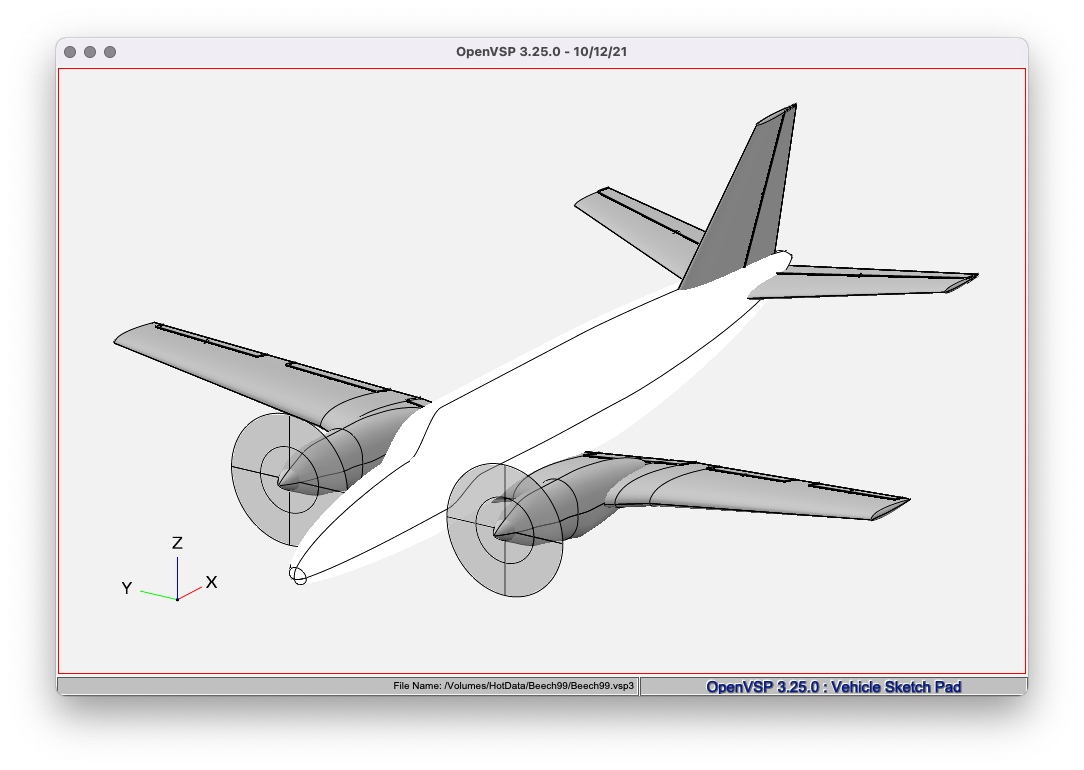
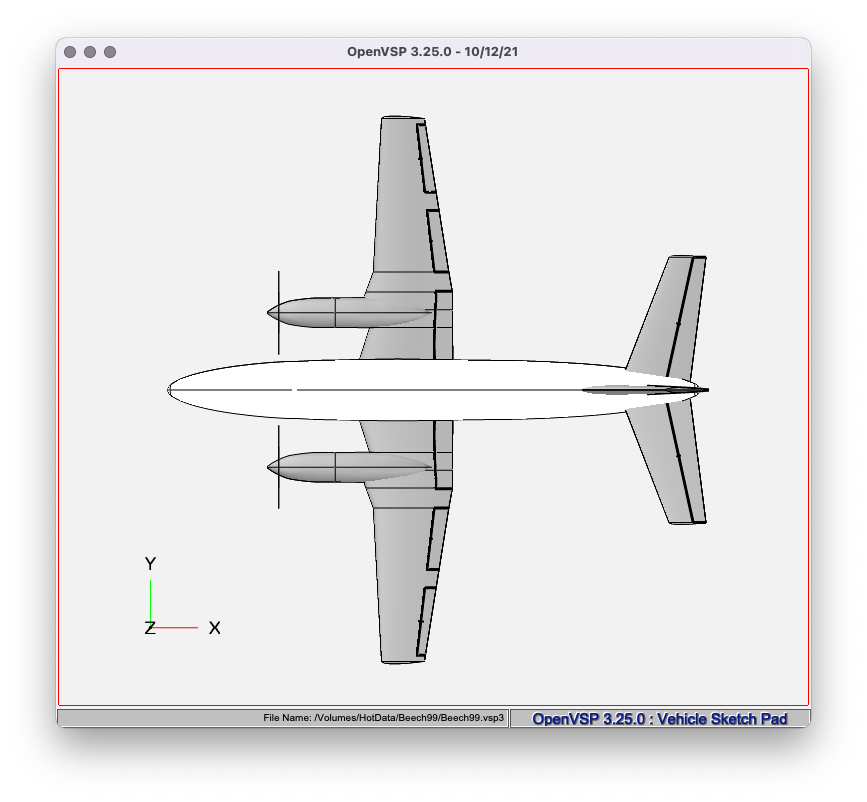
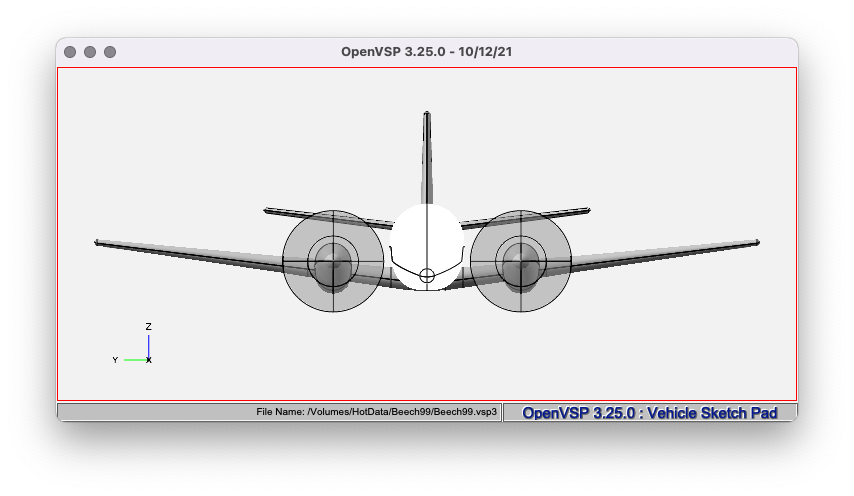
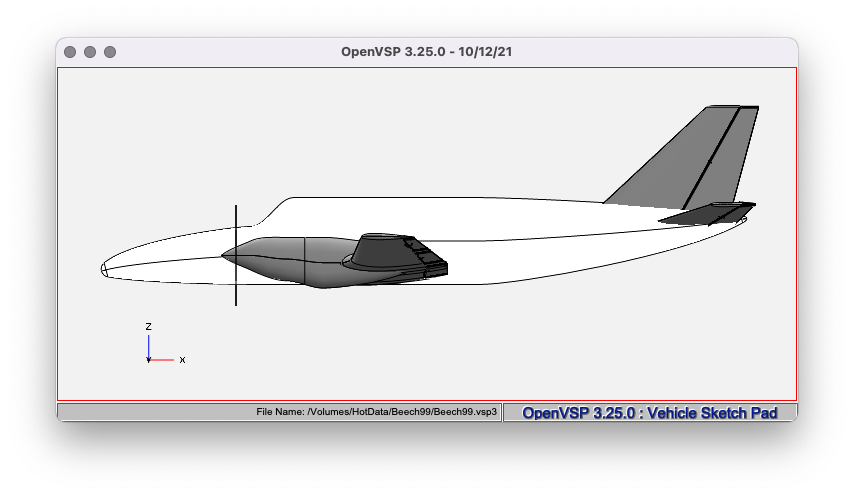
Steady Flight
Lift-Drag Ratio
By the equation 5.24 [1] :
First, we need $C_{D,0}$ . Calculate the $C_{D,0}$ from 0 to 0.4 Mach by VSPAero:
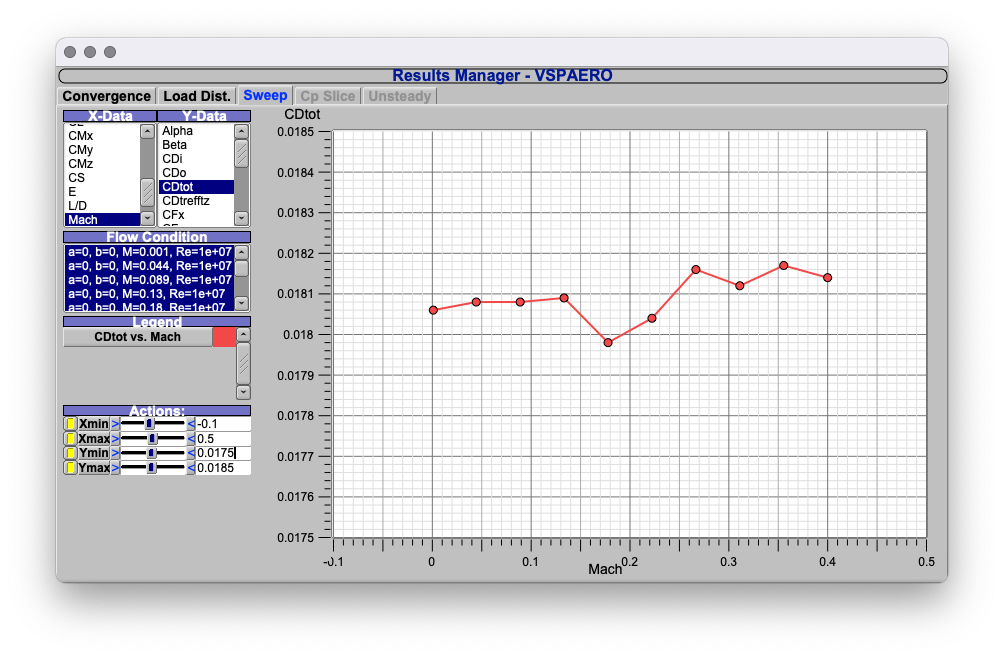
So, the $C_{D,0} \approx 0.018$ .
Use VSPAero to simulate the L/D varies from AOA:
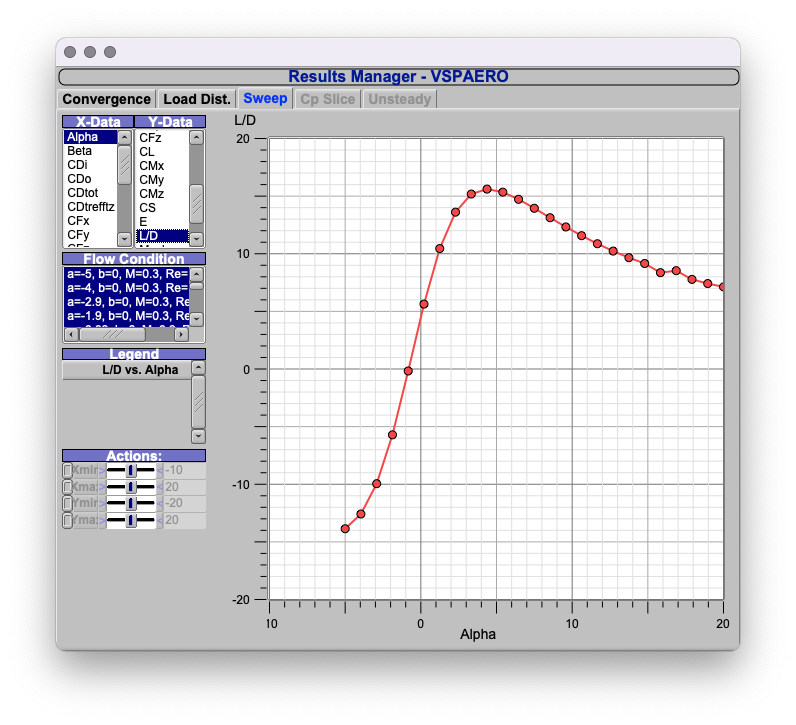
As shown in figure, the maximum of L/D is around 16 when $\alpha = 4 ^{\circ}$.
Then, we know the $K \approx 0.055$ .
Minimum Thrust
From equation 5.21 [1] :
$K = 0.055$, $C_{D,0} \approx 0.018$ :
Empty weight W = 6,000 lbs,
The velocity for minimum thrust and maximum L/D is:
According to the real-life velocity (see in the appendix), this speed is close to the best glide speed and best climb speed. Which match the property of maximum L/D.
Maximum Velocity
By the equation 5.50 [1], the maximum velocity can be calculated by:
We know the empty weight is 6,000 lbs, wing aera is 280 ft^2, maximum thrust is 1,550 lbs.
From previous calculation, $C_{D,0} \approx 0.018$ and $K = 0.055$. Hence,
The result is beyond the real-life maximum velocity, which is 226 kts. Major reason is that the propeller can not maintain the max thrust at that speed. And plane can not fly with empty weight.
Stall Speed
By the equation 5.67 [1] :
Because VSPAero can not simulate flow separation, so I use the property of root airfoil (NACA 23018) from XFoil:
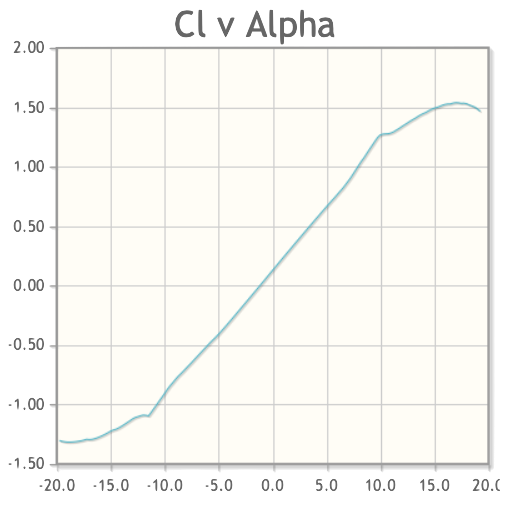
So, we assume the $(C_L)_{\rm max}$ occurs when $\alpha_{\rm stall} = 17 ^{\circ}$:
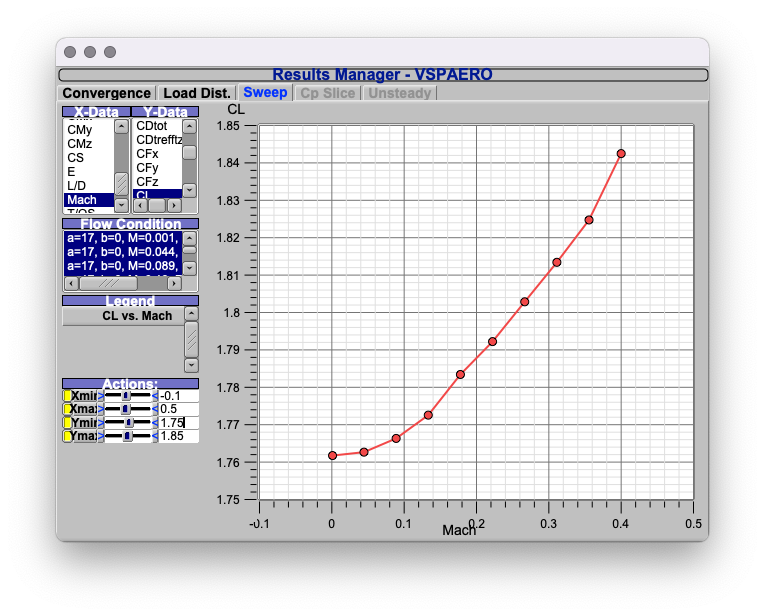
Then, the $(C_L)_{\rm max} \approx 1.8$ ,
The result is close to the actual stall speed. Which is 65 kts. Because I use the empty weight, the result is smaller than real value.
Climbing
From the equation 5.94 [1] , we can calculate the maximum climb angle $\theta_{\rm max}$ :
Previous cases show that $T=1,550 \ \rm lbs$, $W = 6,000 \ \rm lbs$, $(L/D)_{\rm max} = 16$. So, $\theta_{\rm max} = 11.3 ^{\circ}$.
Then, by the equation 5.98 [1] , the max angle-of-climb speed:
Which is vary close to the real-life value 101 kts.
The maximum rate of climb is:
Bigger than the actual rate of climb: 1,700 ft/min. Probably is that the actual climbing will not operate at the maximum angle-of-climb.
Range
As the Beech 99 is turbo-prop plane, we use equation 5.152 [1] :
And set conditions:
- Fly at maximum L/D, which is 16.
- Have the highest possible propeller efficiency.
- Have the lowest possible specific fuel consumption.
- Have the highest possible ratio of gross weight to empty weight.
Data shows the fuel consumption is 74.6 GPH, and one gallon of jet fuel should weigh 6.7 lbs.
The standard weight is 6,000 + 1,600 lbs. Using the minimum thrust equation $\eqref{T_R_min}$, we set the normal thrust is 500 lb.
So the thrust specific fuel consumption:
Then, let gross weight $W_0 = 10,400\ \rm lb$, empty weight $W_1 = 6,000\ \rm lb$. The velocity for minimum thrust and maximum L/D is 178 ft/s.
The result is 1707 km and official maximum range is 1686 km. Considering the difference condition of range testing, this result match vary well.
Endurance
Use equation 5.167 [1] , we use the standard condition (1,600 lbs fuel):
Considering that we ignore the take-off, landing process and passengers. This result is close to the official value (2.9 hrs).
Accelerated Flight
Level Turn
Use the equation 6.33 and 6.31 [1] at standard condition:
I can not find real-life minimum turning radius. But in the book, example 6.1 calculate a Gulfstream-like airplane which has minimum radius of 861 ft. Considering Gulfstream is turbojet plane and Beech 99 is turbo-prop plane. I think this is an reasonable result.
This speed just over the stall speed (65 kts). It can be explained by intuition that smaller velocity can make a faster turn.
Take off
First, use the approx equation 6.95 [1] :
1170 ft is way shorter than official distance 2480 ft. So, I guess the ground effect weaken the thrust. After calculation, we assume the thrust is 731 lbs.
Then, we continue the calculation:
So, the total take off distance $=s_g + s_a = 3162\text{ ft}$, approximately equal to the real distance 3200 ft.
References
[1] John D. Anderson, Jr. Aircraft performance and design.
[2] https://wiki.flightgear.org/Beechcraft_Model_99
[3] https://m-selig.ae.illinois.edu/apasim/Aircraft-uiuc/beech99-v1/
Appendix
Critical Velocity
| Meaning | kts | |
|---|---|---|
| V_stall | Stall Speed | 65 |
| V_mca | Minimum control speed in the air | 85 |
| V_r | Rotation Speed | 100 |
| V_bg | Best Glide Speed | 100 |
| V_x | Best Angle-of-Climb Speed | 101 |
| V_y | Best Rate-of-Climb Speed | 120 |
| V_lo | Maximum Velocity for Landing gear Operation | 130 |
| V_le | Maximum Velocity of Landing gear Extended | 150 |
| V_a | Manoeuvring Speed | 165 |
| V_fe | Maximum Flap Extended Speed | 170 |
| V_no | Velocity of Normal Operations | 200 |
| V_c | Cruise True Airspeed | 205 |
| V_ne | Velocity Never Exceed | 226 |
General Preformance
| Value | Value | ||
|---|---|---|---|
| Takeoff Distance | 2,480 ft | Maximum Trust | 1,550 lbs |
| Takeoff Over 50 ft | 3,200 ft | Max Fuel Capacity | 368 gal |
| Landing Distance | 1,810 ft | Fuel Burn | 74.6 GPH |
| Landing over 50 ft | 2,650 ft | Endurance (full fuel) | 4.4 hrs |
| Service Ceiling | 26,200 ft | Endurance (1600 lb std) | 2.9 hrs |
| Empty Weight | 6,000 lbs | Range | 910 NM |
| Max Takeoff Weight | 10,400 lbs |
Engine Performance
| Condition | Max HP | Max RPM |
|---|---|---|
| Take-off | 550 | 2200 |
| Climb | 538 | 2200 |
| Cruise | 495 | 2200 |
| Idle | 1800 | |
| Acceleration | 2420 | |
| Reserve | 500 | 2090 |
Linear areo data
| CD_0 | Drag Coefficient at 0 | 0.027 | Cl_r | Roll Moment Due to Yaw Rate | 0.14 |
| CD_a | Drag Curve Slope | 0.131 | CL_a | Roll Moment Due to Aileron | -0.156 |
| CL_0 | Lift Coefficient at 0 | 0.201 | Cl_dr | Roll Moment Due to Rudder | 0.0109 |
| CL_a | Lift Curve Slope | 5.48 | C.G | Center of Gravity Location | 16% |
| CL_adot | Lift Due to AOA Rate | 2.5 | b | Wing Span | 46 ft |
| CL_q | Lift Due to Pitch Rate | 8.1 | c_bar | Mean Aerodynamic Chord | 6.5 ft |
| CL_e | Lift Due to Elevator | 0.6 | S | Wing Surface Area | 280 ft^2 |
| Cm_0 | Pitch Moment at 0 | 0.05 | l | Aircraft Length | 45 ft |
| Cm_a | Pitch Moment Due to AOA | -1.89 | I_xx | Roll Inertia | 10085 slug ft^2 |
| Cm_adot | Pitch Moment Due to AOA Rate | -9.1 | I_yy | Pitch Inertia | 15148 slug ft^2 |
| Cm_q | Pitch Moment Due to Pitch Rate | -34.0 | I_zz | Yaw Inertia | 23046 slug ft^2 |
| Cm_e | Pitch Moment Due to Elevator | -2.0 | I_xz | Lateral Cross Inertia | 1600 slug ft^2 |
| Cl_beta | Dihedral Effect | -0.13 | CL_max | Max Lift Coefficient | 1.75 /rad |
| Cl_p | Roll Damping | -0.197 |
Airplane CAD




